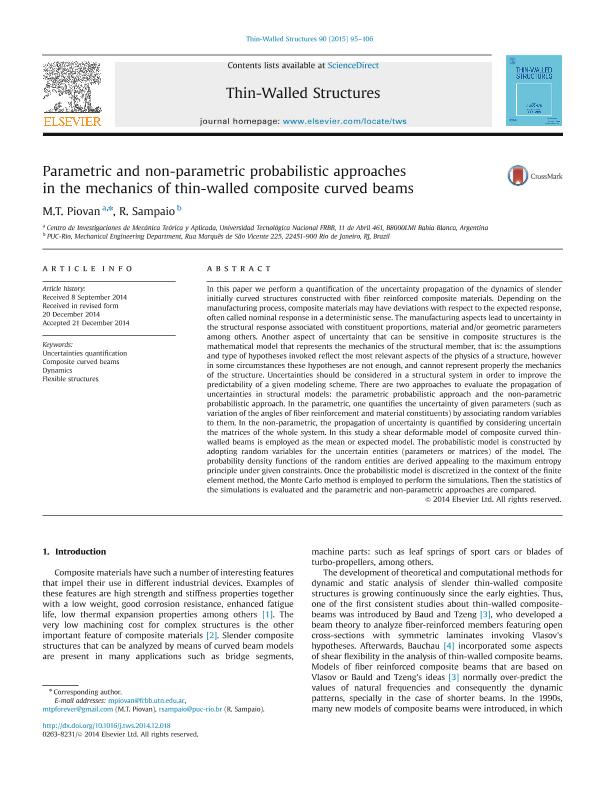Mostrar el registro sencillo del ítem
dc.contributor.author
Sampaio, Rubens
dc.contributor.author
Piovan, Marcelo Tulio

dc.date.available
2016-12-28T17:00:37Z
dc.date.issued
2015-05
dc.identifier.citation
Sampaio, Rubens; Piovan, Marcelo Tulio; Parametric and non-parametric probabilistic approaches in the mechanics of thin-walled composite curved beams; Elsevier; Thin-walled Structures; 90; 5-2015; 95-106
dc.identifier.issn
0263-8231
dc.identifier.uri
http://hdl.handle.net/11336/10475
dc.description.abstract
In this paper we perform a quantification of the uncertainty propagation of the dynamics of slender initially curved structures constructed with fiber reinforced composite materials. Depending on the manufacturing process, composite materials may have deviations with respect to the expected response, often called nominal response in a deterministic sense. The manufacturing aspects lead to uncertainty in the structural response associated with constituent proportions, material and/or geometric parameters among others. Another aspect of uncertainty that can be sensitive in composite structures is the mathematical model that represents the mechanics of the structural member, that is: the assumptions and type of hypotheses invoked reflect the most relevant aspects of the physics of a structure, however in some circumstances these hypotheses are not enough, and cannot represent properly the mechanics of the structure. Uncertainties should be considered in a structural system in order to improve the predictability of a given modeling scheme. There are two approaches to evaluate the propagation of uncertainties in structural models: the parametric probabilistic approach and the non-parametric probabilistic approach. In the parametric, one quantifies the uncertainty of given parameters (such as variation of the angles of fiber reinforcement and material constituents) by associating random variables to them. In the non-parametric, the propagation of uncertainty is quantified by considering uncertain the matrices of the whole system. In this study a shear deformable model of composite curved thinwalled beams is employed as the mean or expected model. The probabilistic model is constructed by adopting random variables for the uncertain entities (parameters or matrices) of the model. The probability density functions of the random entities are derived appealing to the maximum entropy principle under given constraints. Once the probabilistic model is discretized in the context of the finite element method, the Monte Carlo method is employed to perform the simulations. Then the statistics of the simulations is evaluated and the parametric and non-parametric approaches are compared.
dc.format
application/pdf
dc.language.iso
eng
dc.publisher
Elsevier

dc.rights
info:eu-repo/semantics/openAccess
dc.rights.uri
https://creativecommons.org/licenses/by-nc-sa/2.5/ar/
dc.subject
Uncertainties Quantification
dc.subject
Composite Curved Beams
dc.subject
Dynamics
dc.subject
Flexible Structures
dc.subject.classification
Mecánica Aplicada

dc.subject.classification
Ingeniería Mecánica

dc.subject.classification
INGENIERÍAS Y TECNOLOGÍAS

dc.title
Parametric and non-parametric probabilistic approaches in the mechanics of thin-walled composite curved beams
dc.type
info:eu-repo/semantics/article
dc.type
info:ar-repo/semantics/artículo
dc.type
info:eu-repo/semantics/publishedVersion
dc.date.updated
2016-12-27T20:28:20Z
dc.journal.volume
90
dc.journal.pagination
95-106
dc.journal.pais
Países Bajos

dc.journal.ciudad
Amsterdam
dc.description.fil
Fil: Sampaio, Rubens. Pontificia Universidad Catolica Do Rio de Janeiro; Brasil
dc.description.fil
Fil: Piovan, Marcelo Tulio. Universidad Tecnológica Nacional. Facultad Regional Bahía Blanca; Argentina. Consejo Nacional de Investigaciones Científicas y Técnicas; Argentina
dc.journal.title
Thin-walled Structures

dc.relation.alternativeid
info:eu-repo/semantics/altIdentifier/url/http://www.sciencedirect.com/science/article/pii/S0263823114003826
dc.relation.alternativeid
info:eu-repo/semantics/altIdentifier/doi/http://dx.doi.org/10.1016/j.tws.2014.12.018
Archivos asociados
